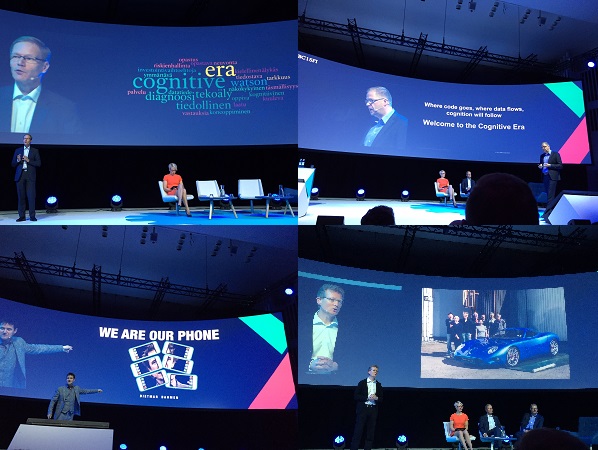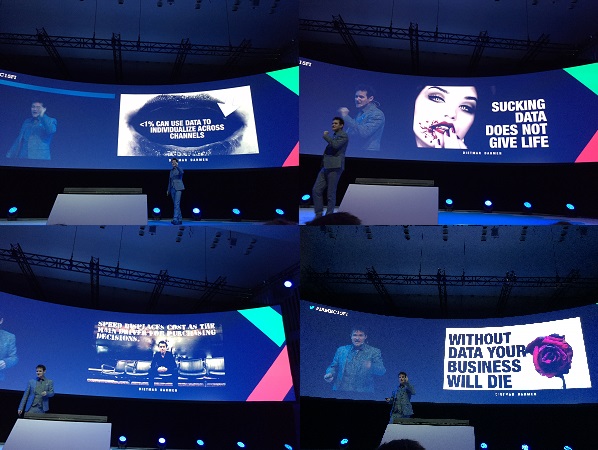Posted: October 23rd, 2015 | Author: Malla Poikela | Filed under: Events | Tags: digital buying experience, innovation, intelligent data, telecom | No Comments »
The theme for last week’s IBM Business Connect event in Helsinki was “Seize the Moment.” Acknowledging the rapidly shifting business environment and ever-increasing consumer demands, event speakers encouraged attendees to get off the sidelines, rapidly build their skills and proactively seek out new ideas to transform their businesses for a new post-digital era.
A number of business leaders, technology experts and futurists presented inspiring talks on their vision for the future of digitalisation, but three keynotes stood out most prominently. The first involved a view of the futuristic technologies businesses will require to push themselves forward, the second stressed the importance of pushing boundaries, and the third encouraged businesses to accept what they don’t know and focus on improving the post-digital buying experience, mirroring what Comptel has said on the topic of Operation Nexterday. Here’s our recap.
A Peek at IBM’s Post-Digital Cognitive Era
IBM has positioned itself as a frontrunner in the “cognitive era,” characterized by a new capability that the tech giant believes companies will need as they move further, and even beyond, the digital era. In his keynote, IBM’s Juha Teljo, who leads European sales for IBM’s business intelligence and predictive analytics technologies, described why cognitive abilities will be the next significant technology for forward-thinking companies.
Cognition, Teljo explains, will allow businesses to understand, reason and learn much in the same way that humans do. Rather than rely on static data for business decision-making, IBM believes the next generation of business intelligence will offer predictive, machine-learned insights through cognitive technology.
This echoes Comptel’s thoughts around operators’ need for intelligent fast data, which drives real-time, automated and contextual marketing, in-the-moment analysis and instant revenue opportunities. Given the speed at which consumers make decisions and demand results, cognition and machine-learning capabilities will be crucial tools moving forward.

Toroidion’s Pasi Pennanen on Pushing Boundaries
It takes imagination to create big ideas, but to accomplish them takes “the next level of courage,” as Pasi Pennanen’s Toroidion project shows.
One might say that Pennanen has plenty of both, and in his keynote he shared his truly fascinating story of how he applied imagination and courage to make his dream of an electric vehicle reality. Pennanen is the creator of the Toroidion 1MW concept car, an eye-popping 100 percent electric sports car with 1,341 horsepower – making it one of the most powerful cars of any type in world.
Pennanen explained how he dreamed of becoming an industrial designer for cars since he was a child – a perhaps atypical ambition for a Finnish youth, but nonetheless one he pursues to this day with the dogged belief that anything is possible. He originally designed the Toroidion to compete in the famous Le Mans 24-hour road race, but now says he envisions his cars eventually being mass produced for everyday consumers.
To achieve that goal, he and his company will need to overcome a great number of challenges and obstacles, but Pennanen is driven to push boundaries in product development and design. It’s a model any business – but especially operators faced with a rapidly evolving telco landscape – should follow.
Futurist Dietmar Dahmen on Accepting the Unknown, Loving the Unknown and Embracing the Unknown
Right now, most operators acknowledge that they are surrounded by a significant number of opportunities coming from all sides. Whether they want to re-engineer their infrastructure for better flexibility and agility through network functions virtualisation, enhance their analytics capabilities through machine-learning technology or design imaginative service plans at warp speed that pique consumers’ interest, there are no shortage of options to revolutionise one’s business.
The challenge is, many operators don’t know which opportunities are right for them or how to proceed. There’s plenty of uncertainty surrounding these decisions, but in his keynote at the event, futurist Dietmar Dahmen expressed why it is important for businesses to accept and even embrace the unknown. As he explained, change is what makes us strong, and though it may feel comfortable to stay within the status quo, businesses must understand that to be a superhero in their industry, they must feel good about breaking rules, thinking exponentially and acting on their potential.

“Without Data Your Business Will Die”
In the digital and cloud era we’re online and connected pretty much 24/7. Dieter Dahmen’s statement ‘We are our phone’ is spot-on to describe our behaviour. Life is truly a chain of digital moments, but businesses are not able to respond to the opportunity that customers’ passive and active digital footprints allow. More than ever, it’s critical to leverage personalization and contextuality to deliver the right content to customers in the right moment. Unfortunately most organizations fall short, as “only 1 percent of companies can use data to invidualise across the channels,” according to Dahmen.
The consumer buying process is the most transformative experience industries need to deal with in the future. Pace is at the heart of it: our new generation of customers are impatient, want options and don’t like to wait. Dietmar Dahmen described it by saying “speed displaces cost as the main driver for purchasing decisions,” which makes moving at the speed of the internet a “life and death matter” for operators. But it’s very clear that at telco speeds, operators will struggle to satisfy clientele.
That’s a message Comptel shares: to break out of the collective industry blind spot and leverage new avenues of growth and revenue, operators must overcome their fear of the unknown and embrace out-of-the-box thinking. It’s the only way forward in Nexterday.
Register to join hundreds of progressive thinkers, industry experts and innovative operators at Comptel’s inaugural Nexterday North, 9-10 November. By purchasing a 2×2 Front Pass, you get full access to both Nexterday North and the startup conference Slush.
Posted: April 24th, 2015 | Author: Juhani Hintikka | Filed under: News | Tags: business review, financials, intelligent data, service orchestration, strategy | No Comments »
Comptel’s net sales and profit grew significantly during the first quarter of 2015, which continued the trend from the second half of 2014. Our European operations especially continued strong sales in Q1. Our FlowOne Fulfillment solution continued, as in the last year, to be our main growth driver.
We were also awarded a deal with a new customer in Indonesia, together with our strategic partner, Tech Mahindra. Strategically, this was an important deal, as Indonesia is defined in our strategy as one of our target growth markets. Our backlog continued to be strong with a 32.3% increase compared to the previous year.
In Q1, we invested in development areas as defined in our updated strategy. Despite our investments, profitability continued to improve, and our operating results grew 55.7% year over year. During the first quarter, we secured three significant orders, valued over EUR 0.5 million. A few Q1 forecasted orders were delayed to the beginning of Q2.
Business Review of Q1 2015
Comptel’s net sales increased in the first quarter by 16.3 per cent from the previous year, to 21.0 million (18.0). The net sales increase was due to the strong backlog at the end of the year. European sales continued with strong growth as in the second half of last year.
The operating result for the period was EUR 1.5 million (1.0), which corresponds to 7.1 per cent of net sales (5.3). The profitability improvement is all attributable to the growth in net sales.
The result before taxes was EUR 0.8 million (0.8), and the net result was EUR 0.29 million (0.15). Net profit improved by 92.3 per cent. Earnings per share for the period under review were EUR 0.00 (0.00).
The Group’s financial income/expenses were EUR -0.7 million, which is a result of US dollar long-term strengthening. The tax expense for the period was EUR 0.5 million (0.6), of which EUR 0.3 million were withholding taxes related to double taxation (0.7).
The Group’s order backlog increased from the previous year and was EUR 55.8 million (42.2) at the end of the period.
Comptel Strategy
Life is digital moments. Digital demand will be driven by “Generation Cloud” customers and enterprises interacting with millions of digital applications. The Internet of Things with billions of connected devices will further accelerate digital demand, leading to exploding data volumes. Future mobile and fixed networks will provide hyper speeds and undergo a transformation from hardware to software. Network functions will be virtualised. Mounting complexity will require orchestration of business flows and virtualised resources.
Comptel’s mission is to perfect digital moments and translate them into business moments by connecting digital demand and supply.
The Comptel strategy focuses on providing solutions for digital and communications service providers in two major areas – Intelligent Data and Service Orchestration. The Intelligent Data business delivers solutions and services to customers for monetising data and turning Big Data into intelligent, automated actions. The Service Orchestration business area provides solutions and services for business flow orchestration and mastering the digital buying experience.
Comptel’s strategic target is to establish itself as a leading software vendor for connecting digital demand and supply.
Strategy execution is based on six strategic objectives: solutions with unique value, thought leadership, customer excellence, new markets, leverage by partners and inspired people.
Comptel´s marketing strategy strives for industry thought leadership on carefully selected themes and topics which are: the digital buying experience, monetising more with less time, orchestration of service and order flows from ground to cloud, and intelligent fast data. The essence of Comptel’s thought leadership is captured in the book, Operation Nexterday, that was launched at Mobile World Congress in March 2015.
We expect 2015 net sales to grow compared to the previous year, and we expect operating profit to be in the range of 8-12%, excluding one-time charges.
Posted: April 2nd, 2015 | Author: Mikko Jarva | Filed under: Industry Insights | Tags: analytics, big data, intelligent data, machine-learning | 1 Comment »
For some digital and communications services provider executives, the Big Data trend has been a big disappointment. Operators were entranced by the idea that rich data analysis can reveal targeted insights that drive more revenue, but not every telco has seen its analytics investments turn into real business results. That has created some noticeable Big Data frustrations.
Research firm Gartner tracks market enthusiasm for emerging technologies with its “Hype Cycle,” and last year, Big Data moved from the “peak of inflated expectations” to the “trough of disillusionment.” While that sounds bad at first glance, it really means that businesses are moving beyond the stage of unrestrained expectations and instead starting to ask practical questions about how Big Data can actually solve their problems.
This more realistic view of Big Data means that when a project falls short of expectations, results-oriented executives may be less forgiving of the entire premise. But, is a lack of ROI an indictment on data analytics as a whole, or is it more a reflection of poor execution?
At Comptel, we argue it is the latter. As my colleague, Malla Poikela, wrote in a recent piece for LinkedIn Pulse, the most common hallmarks of a poor-performing Big Data initiative include difficulties accounting for every new raw data source and then turning all of that data into real-time contextual decisions and actions.
Successful programs rely on relevant actionability. Relevance comes from identifying contexts in real-time data, implying specific needs and employing predictive analytics to optimise target selection for those needs. Actionability is achieved through an end-to-end, integrated, real-time process that connects data streams through analysis to action.
It’s not about Big Data. It’s about Intelligent Fast Data, and it’s the only way to treat information at a time when technology empowers consumers to make informed buying decisions faster than ever and complexity grows in multiple dimensions simultaneously.
What are the benefits? With better understanding of existing customers and their preferences, operators can cue up the personalised service offers that customers want at exactly the right time on any device. It’s real-time marketing, driven by in-the-moment analysis, which leads to instant revenue opportunities.
More generally, Intelligent Fast Data can be considered a process that constantly monitors various forms of digital demand and connects that demand with available digital supply, be it a subscriber needing faster bandwidth temporarily to watch a video on demand, a network requiring additional capacity from virtualized packet core functions or supplying a service desk with a data feed from temperature sensors in a connected home.
Here’s how operators can start to make the switch from Big Data to Intelligent Fast Data.
Think Beyond Rules-Based Parameters
One of the downfalls of traditional decision-making system implementations has been a sole reliance on rules-based infrastructure. This form of analytics provides recommendations based on a set of pre-determined rules, but the challenge is that such a system might not be very accurate and can become overly tedious to manage as the number of rules increases. Rules or logics are important decision-making capabilities, but just like in human decision-making, they often need to be supplemented with capabilities such as pattern matching, predictions and anomaly detection. Intelligent Fast Data enables just that: the embedding of machine-learning-driven advanced analytics capabilities into decision-making.
If Insurance, a property and casualty insurer, took this approach to revamp its insurance claim analysis. If stepped up its automation capabilities with an Intelligent Fast Data system, which automatically learns patterns of insurance claims and flags normal claims for automatic processing, while highlighting potentially fraudulent or anomalous claims for further inspection. With the Intelligent Fast Data system the company was able to further reduce manual claims processing work and triple its number of accurately processed claims.
By embracing Intelligent Fast Data (i.e. decision-making automation with embedded analytics), digital and communication services providers can speed up and enhance the process that turns their data streams through analysis and targeted actions into new revenue streams.
Eliminate ‘Data Wrangling’
Another obstacle that could be holding back your switch to Intelligent Fast Data is a phenomenon known as “data wrangling.” According to the New York Times, data scientists can spend 50 to 80 percent of their time and talent essentially prepping data for the analytics process. It’s busywork, and it means you could be taking far too long to turn customer data into action.
To eliminate time-consuming data cleansing and enable faster time to action, a flexible and agile data processing layer is required, particularly one with the ability to integrate information from any digital source, then automatically cleanse, normalise, enrich and transform the data into ready data products and actions, which are consequently delivered to the systems with specific demands. Such a data processing layer must have smart adaption capabilities so that is able to cope with changes in data streams and the addition of new ones without data wrangling.
Remove Purchasing Friction
Changing how you integrate and process data is step one to drawing more value from Intelligent Fast Data investments. However, operators also need to eliminate any potential roadblocks to realising revenue from the insights data provides. This sometimes requires creative solutions.
For example, Indosat, one of Indonesia’s top mobile operators, needed to find a way to monetise mobile revenue opportunities in a country with one major roadblock. Despite being home to more than 250 million residents, only 8 million people in Indonesia have credit cards. That’s 3.3 percent of the population and 7.7 percent of the country’s sizeable base of smartphone users.
Smartphone users in Indonesia can’t simply purchase apps and services on their phone from a stored credit card like consumers elsewhere. However, a creative solution – direct carrier billing for the Google Play store – enabled Indosat to offer its consumers the same purchasing experience smartphone users worldwide enjoy.
Removing this obstacle opened up a new revenue channel for Indosat, and as the operator collects customer app usage data, it will be able to refine this information into insights and actions that drive even more financial benefits.
Intelligent Fast Data, ultimately, allows operators to profit from a wealth of Big Data.
Want to learn more about how Intelligent Fast Data can help you draw more value from new and existing customer relationships? Download our new book, Operation Nexterday, for expert research and insights.








